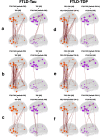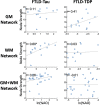Divergent Histopathological Networks of Frontotemporal Degeneration Proteinopathy Subytpes
- PMID: 35318284
- PMCID: PMC9087810
- DOI: 10.1523/JNEUROSCI.2061-21.2022
Divergent Histopathological Networks of Frontotemporal Degeneration Proteinopathy Subytpes
Abstract
Network analyses inform complex systems such as human brain connectivity, but this approach is seldom applied to gold-standard histopathology. Here, we use two complimentary computational approaches to model microscopic progression of the main subtypes of tauopathy versus TDP-43 proteinopathy in the human brain. Digital histopathology measures were obtained in up to 13 gray matter (GM) and adjacent white matter (WM) cortical brain regions sampled from 53 tauopathy and 66 TDP-43 proteinopathy autopsy patients. First, we constructed a weighted non-directed graph for each group, where nodes are defined as GM and WM regions sampled and edges in the graph are weighted using the group-level Pearson's correlation coefficient for each pairwise node comparison. Additionally, we performed mediation analyses to test mediation effects of WM pathology between anterior frontotemporal and posterior parietal GM nodes. We find greater correlation (i.e., edges) between GM and WM node pairs in tauopathies compared with TDP-43 proteinopathies. Moreover, WM pathology strongly correlated with a graph metric of pathology spread (i.e., node-strength) in tauopathies (r = 0.60, p < 0.03) but not in TDP-43 proteinopathies (r = 0.03, p = 0.9). Finally, we found mediation effects for WM pathology on the association between anterior and posterior GM pathology in FTLD-Tau but not in FTLD-TDP. These data suggest distinct tau and TDP-43 proteinopathies may have divergent patterns of cellular propagation in GM and WM. More specifically, axonal spread may be more influential in FTLD-Tau progression. Network analyses of digital histopathological measurements can inform models of disease progression of cellular degeneration in the human brain.SIGNIFICANCE STATEMENT In this study, we uniquely perform two complimentary computational approaches to model and contrast microscopic disease progression between common frontotemporal lobar degeneration (FTLD) proteinopathy subtypes with similar clinical syndromes during life. Our models suggest white matter (WM) pathology influences cortical spread of disease in tauopathies that is less evident in TDP-43 proteinopathies. These data support the hypothesis that there are neuropathologic signatures of cellular degeneration within neurocognitive networks for specific protienopathies. These distinctive patterns of cellular pathology can guide future efforts to develop tissue-sensitive imaging and biological markers with diagnostic and prognostic utility for FTLD. Moreover, our novel computational approach can be used in future work to model various neurodegenerative disorders with mixed proteinopathy within the human brain connectome.
Keywords: TDP-43 proteinopathy; frontotemporal lobar degeneration; histopathology; mediation analysis; network science; tauopathy.
Copyright © 2022 Chen et al.
Figures







References
-
- Boluda S, Iba M, Zhang B, Raible KM, Lee VM, Trojanowski JQ (2015) Differential induction and spread of tau pathology in young PS19 tau transgenic mice following intracerebral injections of pathological tau from Alzheimer's disease or corticobasal degeneration brains. Acta Neuropathol 129:221–237. 10.1007/s00401-014-1373-0 - DOI - PMC - PubMed
-
- Brettschneider J, Del Tredici K, Irwin DJ, Grossman M, Robinson JL, Toledo JB, Fang L, Van Deerlin VM, Ludolph AC, Lee VM, Braak H, Trojanowski JQ (2014) Sequential distribution of pTDP-43 pathology in behavioral variant frontotemporal dementia (bvFTD). Acta Neuropathol 127:423–439. 10.1007/s00401-013-1238-y - DOI - PMC - PubMed
Publication types
MeSH terms
Substances
Grants and funding
LinkOut - more resources
Full Text Sources
